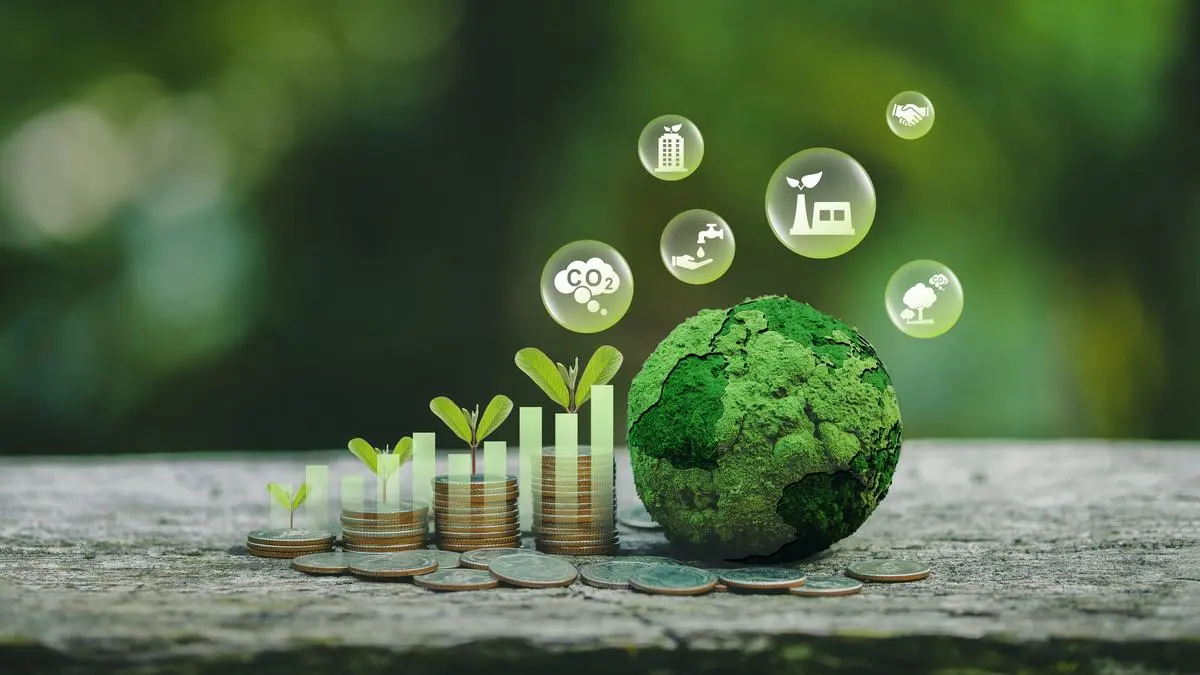India’s Climate Finance Landscape: Progress, Challenges, and the Road Ahead
India’s climate actions so far have primarily been financed from domestic resources. These include government budgetary support, a mix of market mechanisms, fiscal instruments, and policy interventions.
India’s initial Nationally Determined Contribution (NDC) under the Paris Agreement estimated that the country’s climate action would require $2.5 trillion (at 2014-15 prices) for meeting climate change actions between 2015 and 2030. The NDC aims to reduce the emissions intensity of India’s GDP by 45 per cent by 2030 from the 2005 level.
In November 2022, India submitted its Long-Term Low-Carbon Development Strategy to the United Nations Framework Convention on Climate Change (UNFCCC). Several estimates regarding India’s financial needs for this strategy vary due to differences in assumptions, coverage, and modelling approaches. However, these estimates suggest that the requirement will exceed $10 trillion by 2050.
Given India’s substantial financial needs for climate action, tapping into global sustainable/green finance and foreign private capital is expected to play a crucial role in achieving its NDC goals. Encouragingly, the size of global sustainable/green debt finance has been growing rapidly in response to climate change challenges.
According to data from the Institute of International Finance (IIF), cumulative global sustainable/green debt issuances since March 2013 reached $8.86 trillion in December 2024, up from $1.5 trillion in June 2019. Of this amount:
– Mature economies accounted for $6.05 trillion (68.25%)
– Emerging economies $1.53 trillion (17.25%)
– Offshore centres $0.30 trillion (3.38%)
– Supranationals $0.98 trillion (11.12%)
### Green Instruments in Sustainable Finance
Debt instruments used for raising sustainable/green finance range widely, including green bonds/loans, green asset-backed securities (ABS), sustainability bonds, social bonds, green municipal bonds, and sustainability-linked bonds/loans.
Among these instruments:
– Green bonds account for the largest share at 37.10%
– Sustainability-linked loans follow with 18.95%
– Sustainability bonds make up 13.14%
– Green loans comprise 10.44%
India’s share in global sustainable/green debt issuances till December 2024 was $91.2 billion, which represents just 1.03% of the global total. However, when viewed as a share of emerging economies’ sustainable/green debt issuances, India’s portion looks more respectable at 5.97%.
By contrast, China’s share in sustainable/green debt issuances was much higher, at $690.7 billion — accounting for 7.80% globally and 45.21% within emerging economies. Clearly, India has considerable ground to cover in increasing its presence in this space.
### Steps Taken and Future Prospects
Several climate-related measures were announced in the Union Budget 2022-23, including the introduction of sovereign green bonds and thematic funds for blended finance. India joined the sovereign green bonds club on January 25, 2023, by raising ₹80 billion. Since then, a few more sovereign green bond issuances have taken place.
While the Securities and Exchange Board of India (SEBI) issued disclosure requirements for the issuance and listing of green debt securities in 2017, Indian corporate entities entered the green bond market earlier — with Yes Bank issuing the first green bond worth $260 million in 2015. Since then, various public and private sector corporate entities have actively raised green finance.
India has been gaining traction in accessing sustainable/green financing both locally and globally. Yet, the financing gap to meet its NDCs under the UNFCCC remains huge. To bridge this gap, India needs to tap into the rapidly growing global pool of sustainable/green capital from pension funds, sovereign wealth funds, insurance funds, private equity, venture capital, infrastructure funds, and more.
### Policy Enablers to Attract Global Green Finance
Attracting global private finance into India’s sustainable/green projects requires a focus on both micro and macro-level policy enablers.
At the micro level, increasing transparency by aligning disclosure and reporting standards to global benchmarks will reduce information asymmetry faced by investors and lenders. Establishing an integrated domestic measurement, reporting, and verification system would enhance the availability and accessibility of sustainable/green finance data.
At the macro level, developing a robust green taxonomy combined with fiscal incentives and a credible domestic capital market is crucial to accelerate the inflow of global private green finance into India.
In this context, the mandatory implementation of Business Responsibility and Sustainability Reporting (BRSR) for the top 1,000 listed companies and the announcement to develop a taxonomy for climate finance in the Union Budget 2024-25 are positive steps. However, much more needs to be done to attract global sustainable/green finance.
For example:
– Developing a dedicated channel for listing green bonds on Indian stock exchanges could help increase visibility.
– Launching or expanding ESG performance-based equity/bond indices on Indian exchanges would incentivize sustainable investment.
– Collaborating with offshore stock exchanges and index providers to include Indian green bonds in global indices could boost international investor interest.
### Conclusion
India stands at a critical juncture in its climate finance journey. While domestic resources have driven much of its climate actions to date, bridging the significant financing gap demands greater engagement with global sustainable finance markets.
Strategic policy reforms, enhanced transparency, and international collaboration will be key to unlocking private capital flows that can support India’s ambitious climate commitments and long-term low-carbon development goals.
—
*The writer is a Professor at the Institute of Development and Communications (IDC), Chandigarh. Views expressed are personal.*
*Published on September 18, 2025.*
https://www.thehindubusinessline.com/opinion/india-needs-to-tap-into-global-green-finance/article70062300.ece
